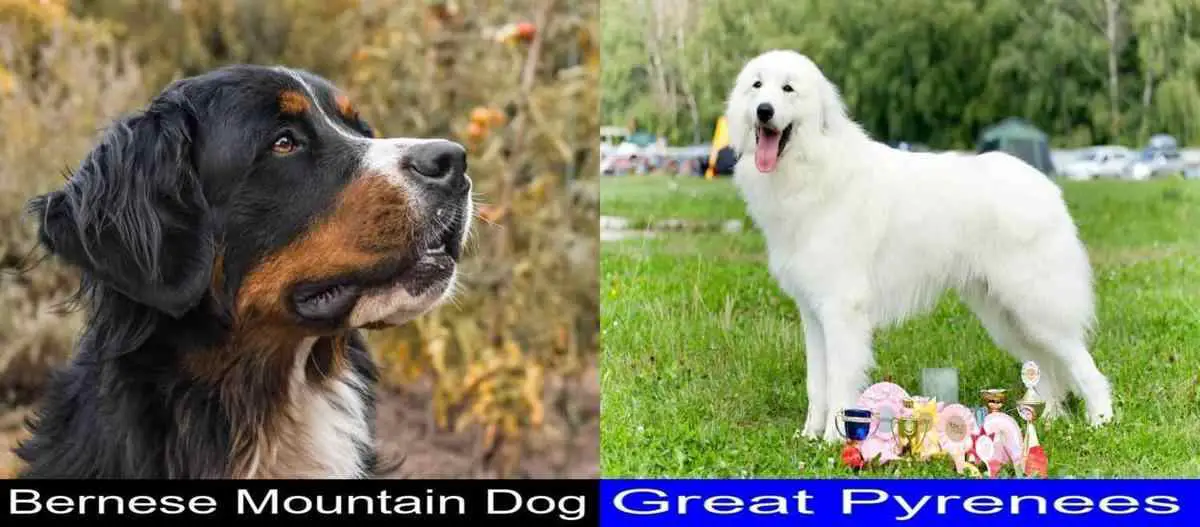Last Updated: Nov 07, 2022
Quick Links: Table of Contents
- Bernese Mountain Dog Versus Great Pyrenees: Introduction
- Bernese Mountain Dog versus Great Pyrenees: Overview
- Bernese Mountain Dog versus Great Pyrenees: Comparison Table
- The Most Remarkable Differences Between the Bernese Mountain Dog and the Great Pyrenees
- The Similarities Between the Bernese Mountain Dog and the Great Pyrenees
- Size Comparison of the Bernese Mountain Dog versus Great Pyrenees
- Appearance (Colors) of the Bernese Mountain Dog and the Great Pyrenees
- Lifespan of Bernese Mountain Dog versus Great Pyrenees
- Temperament of the Great Pyrenees Versus the Bernese Mountain Dog
- Price of Bernese Mountain Dog versus Price of Great Pyrenees
- The Intelligence of the Bernese Mountain Dog versus the Intelligence of the Great Pyrenees
- The Popularity of Bernese Mountain Dog versus Popularity of Great Pyrenees
- Health Problems of Bernese Mountain Dog versus Health Problems of Great Pyrenees
- Tolerates Being Alone: Bernese Mountain Dog versus Great Pyrenees
- Do Bernese Mountain Dogs shed more than Great Pyreneess?
- Which is Easier to Groom, the Bernese Mountain Dog or the Great Pyrenees?
- Which Dog Breed is more Dog-Friendly, the Bernese Mountain Dog or the Great Pyrenees?
- Are Bernese Mountain Dogs good family dogs? What about Great Pyreneess?
- Is the Bernese Mountain Dog Easier to Train than the Great Pyrenees?
- Which one drools more, the Bernese Mountain Dog or the Great Pyrenees
- How Kid-friendly are Bernese Mountain Dogs and Great Pyreneess?
- Does the Bernese Mountain Dog Have a Higher Prey Drive than the Great Pyrenees?
- Do Bernese Mountain Dogs Bark and Howl? What about Great Pyreneess?
- Can Bernese Mountain Dogs Tolerate Cold Weather? And can Great Pyreneess Tolerate Cold Weather?
- Wanderlust Potential: Bernese Mountain Dog vs. Great Pyrenees
- Can Bernese Mountain Dogs Tolerate Hot Weather? Can Great Pyreneess Tolerate Hot Weather?
- Bernese Mountain Dog Versus Other Dog Breeds
- Conclusion: Bernese Mountain Dog versus Great Pyrenees. Which One is a Better Pet?
Bernese Mountain Dog Versus Great Pyrenees: Introduction
Are you thinking of getting a new pet dog, and you have narrowed down your choices to the Bernese Mountain Dog and the Great Pyrenees? Well, you have come to the right place. Because in this article, we will provide you with a detailed comparison of these two dog breeds to help you decide which of the Bernese Mountain Dog and the Great Pyrenees better suits you.
We will provide you a detailed discussion and comparison of dog attributes such as intelligence, price, general health, friendliness, etc, for both the Bernese Mountain Dog and the Great Pyrenees.
Furthermore, we will let you know which one of the Bernese Mountain Dog and the Great Pyrenees is better suited for new dog owners, for owners with kids, for owners that live in apartments, for owners with dog allergies, etc.
Importantly, we did some analysis and calculation and we obtained a number that we call the Better-Pet Score™ for both the Bernese Mountain Dog and for the Great Pyrenees. The dog breed with the higher Better-Pet score is the `better` pet. We hope that these Better-Pet Scores will provide you with more insight into deciding which pet to get between the Bernese Mountain Dog and the Great Pyrenees.
Our only goal here is to help you make a well-thought-out decision on your next long-term companion, be it the Bernese Mountain Dog or the Great Pyrenees.
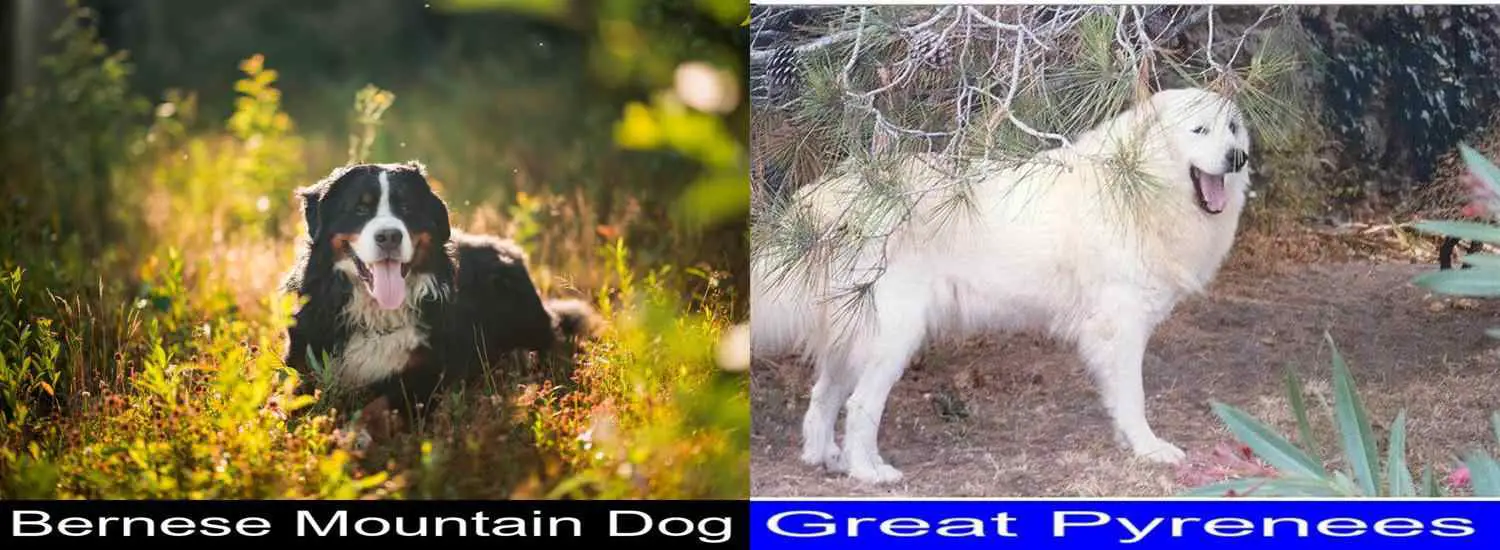
Bernese Mountain Dog versus Great Pyrenees: Overview
Both the Bernese Mountain Dog and the Great Pyrenees are similar in size. The Bernese Mountain Dog and the Great Pyrenees are both giant-sized dogs.
Furthermore, both the Bernese Mountain Dog and the Great Pyrenees are Working Dogs. This means both the Bernese Mountain Dog and the Great Pyrenees were developed to assist humans in some capacity – including pulling sleds and carts, guarding flocks, guarding homes, and protecting their families. Breeds in the Working Group are known for their imposing stature, strength, intelligence, and fearless. Because of their size and strength, working dogs require a structured home life and firm, fair, consistent training by someone who can provide leadership without resorting to anger or physical force.
Bernese Mountain Dog versus Great Pyrenees: Comparison Table
The table below compares the Bernese Mountain Dog to the Great Pyrenees based on different important factors such as Price, Health, Kid-friendliness, etc.
When a dog breed scores higher for a factor than the other dog breed, the box of the breed that scores higher is shaded green and the box of the breed that scores lower is shaded red. When there is no difference between the breeds for a particular factor then the box is shaded gray for both pets. Also, when the factor is not important in picking a pet, or when the factor cannot be compared between two pets, the box for the factor is shaded gray for both pets
Most of the factors in the table for each dog breed are ranked on a scale of 1 to 5. “1” means “worst”, and “5” means “best”.
However, some factors such as “Price”, “Average Lifespan”, etc. cannot be on a scale of 1 to 5, so they are not on a scale of 1 to 5 in the comparison table.
Later in this article, we will further explain each factor as it applies to the Bernese Mountain Dog and the Great Pyrenees
| Factor | Bernese Mountain Dog | Great Pyrenees |
|---|---|---|
| Adapts Well To Apartment Living | 1/5 | 1/5 |
| Tolerates Being Alone | 1/5 | 3/5 |
| Tolerates Hot Weather | 1/5 | 3/5 |
| General Health | 1/5 | 2/5 |
| Good For Novice Owners | 2/5 | 1/5 |
| Height | 23 to 28 inches | 25 to 32 inches tall at the shoulder |
| Dog Friendly | 3/5 | 4/5 |
| Easy To Groom | 3/5 | 4/5 |
| Tendency NOT to Wander | 3/5 | 1/5 |
| Calmness/ Low Vigor | 3/5 | 1/5 |
| Minimal Exercise Needs | 3/5 | 1/5 |
| Easygoing | 2/5 | 2/5 |
| Does NOT Drool | 2/5 | 4/5 |
| Potential NOT to Gain Weight | 2/5 | 2/5 |
| Easy To Train | 4/5 | 1/5 |
| Intelligence | 4/5 | 4/5 |
| Does NOT Bark or Howl | 2/5 | 1/5 |
| NOT Rambunctious | 2/5 | 1/5 |
| Potential For Playfulness | 4/5 | 4/5 |
| Tolerates Cold Weather | 5/5 | 5/5 |
| Affectionate With Family | 5/5 | 5/5 |
| Kid-Friendly | 5/5 | 4/5 |
| Friendly Toward Strangers | 5/5 | 3/5 |
| Does NOT Shed | 1/5 | 1/5 |
| Does NOT chew on things | 1/5 | 4/5 |
| Low Prey Drive | 1/5 | 1/5 |
| Life Span | 6 to 10 years | 10 to 12 years |
| Weight | 70 to 115 pounds | 85 to 160 pounds |
| Average Lifespan | 8.0 years | 11.0 years |
| Average Price | $2390 | $830 |
| Price Range | $1500 – $2995 | $500 – $1000 |
| Temperament Score | 86.6 percent | 84.9 percent |
| Common Health Problems and Recommended Health Tests | ||
| Popularity out of 200 Dog Breeds | 25 | 68 |
| Intelligence Rank (out of 130 Dog Breeds) | 22 | 64 |
Next, we added the scores of the factors that can be added together for the Bernese Mountain Dog in the table (that is, `Ease of Grooming` score + `General Health` score + `Calmness` score + …etc) and we compared it to the corresponding total score for the Great Pyrenees. We call these total scores the Better-Pet Scores, as we mentioned earlier. We called this score the Better-Pet score because the better dog breed will have a higher score. This is because the pet will the higher score will have minimal needs and be easier to have as a pet.
The Better-Pet score for the Bernese Mountain Dog is 66 out of 125 while the Better-Pet score for the Great Pyrenees is 63 out of 125.
Based on their Better-Pet scores, the Bernese Mountain Dog is a better pet than the Great Pyrenees. So, you should get a Bernese Mountain Dog!

The Most Remarkable Differences Between the Bernese Mountain Dog and the Great Pyrenees
Below is a list of where the Bernese Mountain Dog and the Great Pyrenees are most different:
The Similarities Between the Bernese Mountain Dog and the Great Pyrenees
The Bernese Mountain Dog and the Great Pyrenees are very similar in certain aspects. Below is the list of where the Bernese Mountain Dog and the Great Pyrenees are most similar:
Size Comparison of the Bernese Mountain Dog versus Great Pyrenees
Now, let us discuss the difference in size between the Bernese Mountain Dog and the Great Pyrenees.
The Bernese Mountain Dog weighs 70 to 115 pounds when fully grown. The Bernese Mountain Dog is 23 to 28 inches when fully grown.
On the other hand, the Great Pyrenees weighs 85 to 160 pounds when fully grown. The Great Pyrenees is 25 to 32 inches tall at the shoulder when fully grown.

Appearance (Colors) of the Bernese Mountain Dog and the Great Pyrenees
Bernese Mountain Dog Colors
The Bernese Mountain Dog comes in the following beautiful primary colors:
- Tricolor (Brown, Black, & White)
- Black
- Bicolor
- Brindle
- White / Cream
The Bernese Mountain Dog comes in the following lovely secondary colors in addition to its primary colors:
- Brown / Chocolate
- White / Cream
- Tricolor (Brown, Black, & White)
- Red / Chestnut / Orange
Great Pyrenees Colors
The Great Pyrenees comes in the following beautiful primary colors:
- White / Cream
- Apricot / Beige
- Brindle
- Black
- Yellow / Tan / Blond / Fawn
- Merle (Blue)
- Brown / Chocolate
- Gray / Blue / Silver
The Great Pyrenees comes in the following lovely secondary colors in addition to its primary colors:
- Apricot / Beige
- White / Cream
- Yellow / Tan / Blond / Fawn
- Black
- Brown / Chocolate
- Gray / Blue / Silver
Lifespan of Bernese Mountain Dog versus Great Pyrenees
The lifespan of the Bernese Mountain Dog is between 6 to 10 years. The average lifespan of the Bernese Mountain Dog is 8.0 years.
The lifespan of the Great Pyrenees is between 10 to 12 years. The average lifespan of the Great Pyrenees is 11.0 years.
The Great Pyrenees lives longer than the Bernese Mountain Dog.
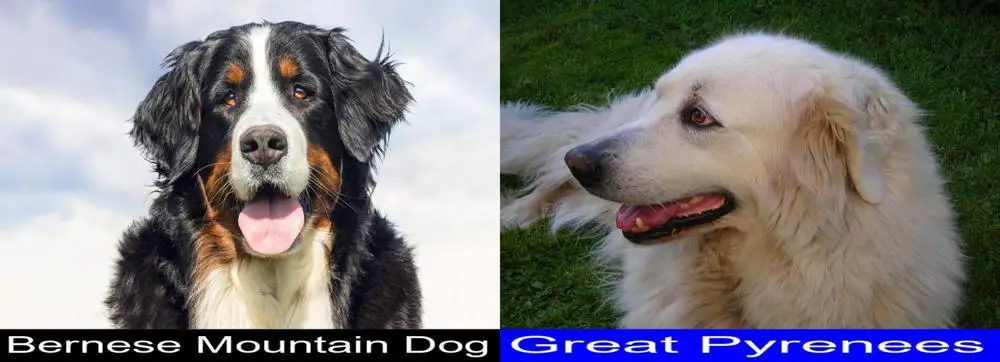
Temperament of the Great Pyrenees Versus the Bernese Mountain Dog
The Bernese Mountain Dog has a better temperament than the Great Pyrenees.
This is because the temperament score for the Bernese Mountain Dog is 86.6 percent while the temperament score for the Great Pyrenees is 84.9 percent, according to the American Temperament Test Society (ATTS).
The American Temperament Test Society (ATTS) is a non-profit organization whose mission is to provide fair and objective evaluations of the temperaments of dog breeds.
Dog breeds with low temperament scores tend to show unprovoked aggression, they easily panic without quickly recovering from the panic, and they tend to avoid people. However, dog breeds with high temperament scores are not aggressive and are not shy. Also, these dogs are generally friendly and are protective of their owners.
The average temperament score across all dog breeds (over 250 breeds) is 83.7 percent.
With its temperament score of 86.6 percent, the Bernese Mountain Dog has an above-average temperament compared to other dog breeds.
With its temperament score of 84.9 percent, the Great Pyrenees has an above-average temperament compared to other dog breeds.
The ATTS obtained the temperament scores of the Bernese Mountain Dog and the Great Pyrenees by measuring the temperaments of 194 Bernese Mountain Dogs and 152 Great Pyreneess.
Price of Bernese Mountain Dog versus Price of Great Pyrenees
The average price of the Bernese Mountain Dog puppy is $2390. The price of the Bernese Mountain Dog typically ranges from $1500 – $2995. However, the price of a Bernese Mountain Dog can be as low as $300 and as high as $10000. We obtained this price information by reviewing the prices of 920 Bernese Mountain Dog puppies listed for sale from various sources.
The average price of the Great Pyrenees puppy is $830. The price of the Great Pyrenees typically ranges from $500 – $1000. However, the price of the Great Pyrenees can be as low as $195 and as high as $2825. We obtained this price information by collecting and reviewing the prices of 352 Great Pyrenees puppies listed for sale from various sources.
The Bernese Mountain Dog is more expensive than the Great Pyrenees.
| Bernese Mountain Dog | Great Pyrenees | |
|---|---|---|
| Average Price | $2390 | $830 |
| Price Range | $1500 to $2995 | $500 to $1000 |
The charts below show the price distribution for the Bernese Mountain Dog and Great Pyrenees. For different price points, the charts show how many Bernese Mountain Dog puppies or how many Great Pyrenees puppies are listed for sale at those price points.
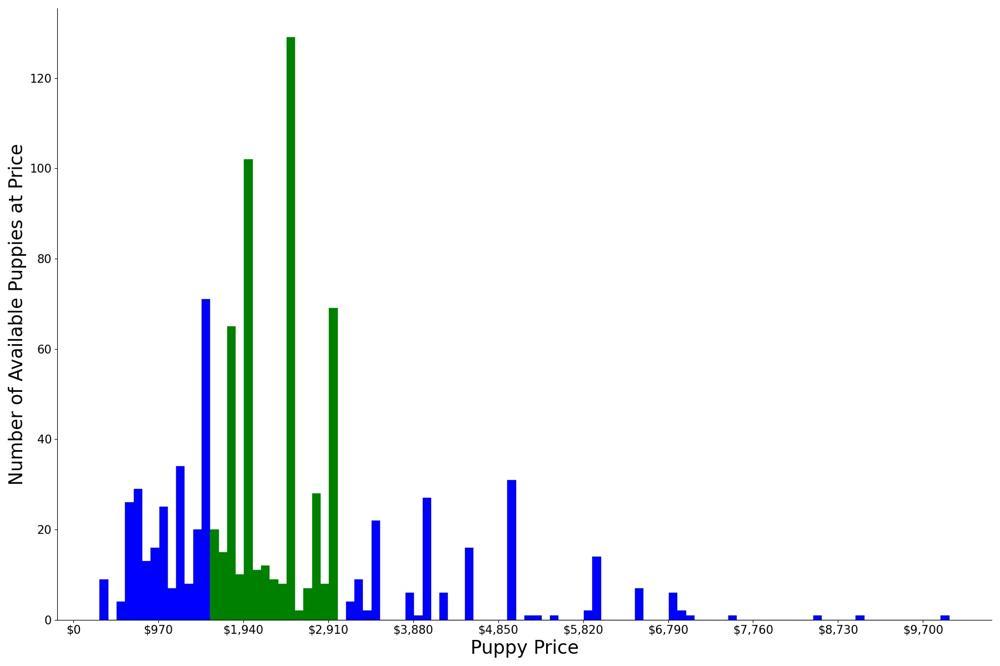
A breakdown of the prices of Bernese Mountain Dogs. The typical price range is shaded Green.

A breakdown of the prices of Great Pyreneess
Note that a lot of factors determine how much you can expect to pay for the Bernese Mountain Dog puppy or the Great Pyrenees puppy. This includes if health screening tests have been performed on the puppy, if the puppy is from a famous pedigree, the US State where the puppy is bred, etc.
Nevertheless, when looking to buy a puppy, look at buying a puppy only from well-established breeders that breed puppies primarily for the love of dogs, and secondarily for profit. Do not buy a puppy from a puppy mill. Puppy mills mass-produce puppies in bad living conditions for maximum profit.
You may also consider adopting a dog instead of buying a dog.
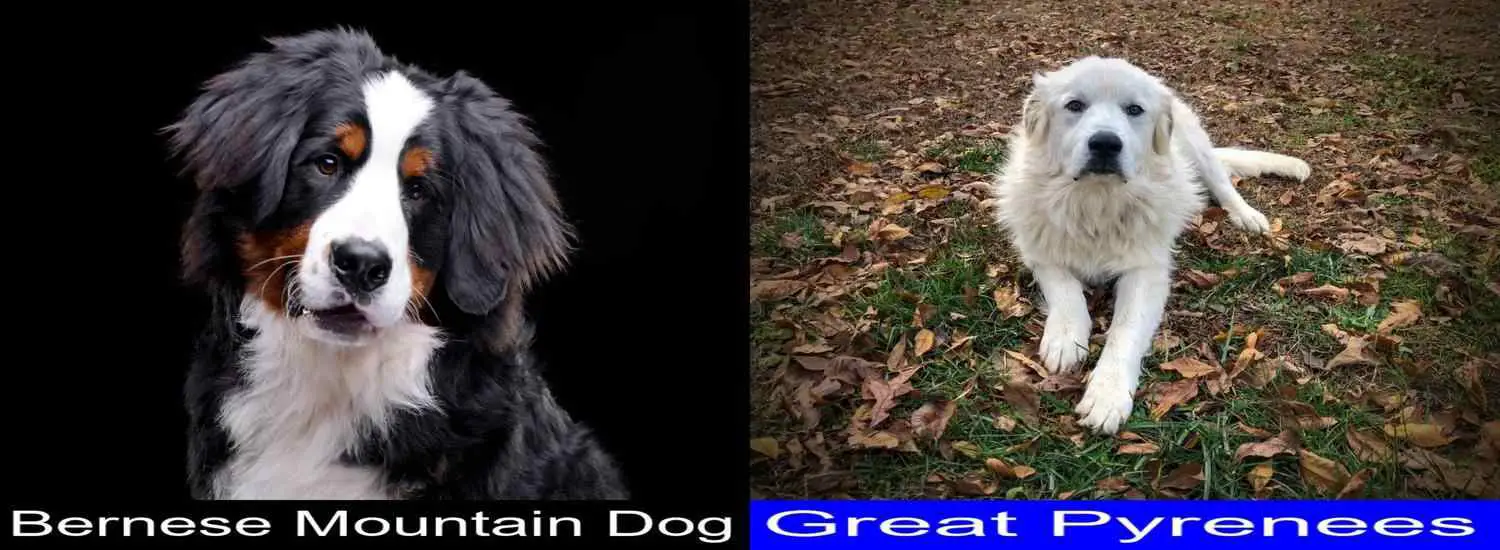
The Intelligence of the Bernese Mountain Dog versus the Intelligence of the Great Pyrenees
| Bernese Mountain Dog | Great Pyrenees | |
|---|---|---|
| Intelligence Rank | 22 out of 130 dog breeds | 64 out of 130 dog breeds |
| Trainability | Tend To Learn New Commands After 5 To 15 Repetitions | Tend To Learn New Commands After 40 To 80 Repetitions! |
Professor Stanley Coren, the famous psychology/neuropsychological professor and, dog lover/trainer measured and ranked the intelligence of about 130 different dog breeds.
According to Prof. Stanley Coren, the total intelligence that a dog demonstrates is the addition of three types of intelligence. These intelligence types are:
Prof. Coren showed that the Working/Obedience Intelligence of different dog breeds can be measured reliably. Thus, he was able to rank different dog breeds based on their Working/Obedience Intelligence.
This is important because according to Prof. Coren, 51 percent of a dog`s intelligence comes from its genes while 49 percent of a dog`s intelligence comes from the dog`s environmental circumstances.
To rank the intelligence of dog breeds, Prof. Coren employed the help of 208 dog obedience judges in North America to fill out a detailed survey on dog obedience. This number represented more than half of all of these judges in North America at the time. He also employed 63 veterinarians and 14 guard dog experts to collect data on the personality of different dog breeds.
Prof. Coren found that the Bernese Mountain Dog has an obedience intelligence rank of 22 out of 130 dog breeds. The Bernese Mountain Dog belongs to the `Excellent Working Dogs` category. This means that Bernese Mountain Dogs tend to learn new commands after 5 to 15 repetitions.
The Great Pyrenees has an obedience intelligence rank of 64 out of 130 dog breeds. The Great Pyrenees belongs to the `Fair Working/Obedience Intelligence Dogs` category. This means that Great Pyreneess tend to learn new commands after 40 to 80 repetitions!.
The Bernese Mountain Dog is more intelligent than the Great Pyrenees.
However, Prof. Coren noted that a dog should not be judged based on its intelligence alone, that other factors such as sociability, adorability, and compatibility with the owner are other very important factors that new dog owners need to consider when deciding on a new dog.
The Popularity of Bernese Mountain Dog versus Popularity of Great Pyrenees
Every year, the American Kennel Club (AKC) publishes information on how popular a dog breed is in that particular year. The AKC gets the popularity information of a breed from how many dogs of that breed the owners register with the AKC every year. The AKC collects this data for about 200 dog breeds. The AKC collects this data for purebred dogs only(no mixed or hybrid dogs).
The graphs and the table below show the popularity of the Bernese Mountain Dog and the Great Pyrenees over the years.
Based on the AKC popularity data over the years, the Bernese Mountain Dog is more popular with dog owners than the Great Pyrenees. This is because, over the years, the average popularity of the Bernese Mountain Dog is 25 out of about 200 dog breeds while the average popularity of the Great Pyrenees is 68 out of about 200 dog breeds.

Popularity of Bernese Mountain Dog

Popularity of Great Pyrenees
| Year | Bernese Mountain Dog Popularity Rank | Great Pyrenees Popularity Rank |
|---|---|---|
| 2013 | 32 | 69 |
| 2014 | 32 | 75 |
| 2015 | 29 | 67 |
| 2016 | 27 | 67 |
| 2017 | 25 | 66 |
| 2018 | 22 | 66 |
| 2019 | 23 | 69 |
| 2020 | 22 | 70 |
| 2021 | 20 | 63 |
Health Problems of Bernese Mountain Dog versus Health Problems of Great Pyrenees
Every dog breed has its own set of health problems that it has a tendency to develop. There is nothing like a perfect dog breed.
Both the Bernese Mountain Dog and the Great Pyrenees are prone to certain genetic health conditions. The Orthopedic Foundation for Animals (OFA) is the organization that keeps track of health problems in dogs. Based on the extensive records that the OFA keeps, the OFA knows what health problems each dog breed is naturally prone to develop. Hence, the OFA recommends which health screening that breeders should perform on a dog breed to make sure that the breeders won`t breed `defective` dog parents that can pass down defective genes to their puppy offspring.
The more health problems a dog breed is prone to develop, the more health tests the OFA will recommend for that dog breed.
Based on our review of OFA records, we found that the Bernese Mountain Dog is prone to more genetic health problems than the Great Pyrenees.
This is because the OFA recommends more screening health tests for the Bernese Mountain Dog than for the Great Pyrenees.
6 health tests are recommended for Bernese Mountain Dog while 5 tests are recommended for the Great Pyrenees.
Below is a detailed discussion of health problems in Bernese Mountain Dogs and in Great Pyreneess.
Bernese Mountain Dog Health Problems
Bernese Mountain Dogs are genetically prone to certain health problems. However, breeders can reduce the chances of producing Bernese Mountain Dog puppies with genetic defects by making sure that a puppy`s parents are free from genetic health problems before allowing the parent to make puppies.
The OFA provides breeders recommendations on which genetic diseases that breeders should screen their dog parents and puppies for.
If you want a Bernese Mountain Dog puppy that will grow up to be healthy, make sure that your Bernese Mountain Dog breeder screens your puppy or your puppy`s parents for the health problems that the OFA recommends for your puppy`s breed. This will increase the chances that your puppy is free from genetic defects.
The following are the health tests that Orthopedic Foundation for Animals (OFA) recommends that breeders should screen Bernese Mountain Dogs for:
You can find out more about OFA`s recommended tests for Bernese Mountain Dogs here.
Great Pyrenees Health Problems
Great Pyreneess are genetically prone to certain health problems. However, breeders can reduce the chances of producing Great Pyrenees puppies with genetic defects by making sure that a puppy`s parents are free from genetic health problems before allowing the parent to make puppies.
The OFA provides breeders recommendations on which genetic diseases that breeders should screen their dog parents and puppies for.
If you want a Great Pyrenees puppy that will grow up to be healthy, make sure that your Great Pyrenees breeder screens your puppy or your puppy`s parents for the health problems that the OFA recommends for your puppy`s breed. This will increase the chances that your puppy is free from genetic defects.
The following are the health tests that Orthopedic Foundation for Animals (OFA) recommends that breeders should screen Great Pyreneess for:
You can find out more about OFA`s recommended tests for Great Pyreneess here.
More Discussions on Health Problems in Bernese Mountain Dogs and Great Pyreneess
Based on our analysis of data from the Orthopedic Foundation for Animals, of all known genetic health problems in dogs, the health problem that is most commonly seen in the Bernese Mountain Dog Breed is Basic Cardiac problems.
This is because the Bernese Mountain Dog ranks 2 out of 16 dog breeds for Basic Cardiac problems. In fact, in a health test conducted on 121 Bernese Mountain Dogs, 0 of them had Basic Cardiac problems.
The genetic diseases that were found to commonly occur in Bernese Mountain Dogs, and how common these diseases are in Bernese Mountain Dogs relative to other dog breeds, are given below:
Based on our analysis of data from the Orthopedic Foundation for Animals, of all known genetic health problems in dogs, the health problem that is most commonly seen in the Great Pyrenees Breed is Canine Multifocal Retinopathy problems.
This is because the Great Pyrenees ranks 1 out of 6 dog breeds for Canine Multifocal Retinopathy problems. In fact, in a health test conducted on 109 Great Pyreneess, 9 of them had Canine Multifocal Retinopathy problems.
The genetic diseases that were found to commonly occur in Great Pyreneess, and how common these diseases are in Great Pyreneess relative to other dog breeds, are given below:
The table below lists the common health problems in Bernese Mountain Dog and in Great Pyrenees and the rank (prevalence), compared to other dogs, of these health problems in the Bernese Mountain Dog and the Great Pyrenees:
| Disease | Bernese Mountain Dog Rank | Great Pyrenees Rank |
|---|---|---|
| Basic Cardiac problems | 2 out of 16 dog breeds | Not Common |
| Elbow problems | 11 out of 144 dog breeds | 112 out of 144 dog breeds |
| Degenerative Myelopathy problems | 17 out of 70 dog breeds | 27 out of 70 dog breeds |
| Shoulder problems | 17 out of 22 dog breeds | 16 out of 22 dog breeds |
| Dentition Database problems | 37 out of 49 dog breeds | Not Common |
| Advanced Cardiac problems | 47 out of 71 dog breeds | Not Common |
| Congenital Cardiac problems | 62 out of 159 dog breeds | 55 out of 159 dog breeds |
| Hips problems | 65 out of 198 dog breeds | 124 out of 198 dog breeds |
| Thyroid problems | 82 out of 115 dog breeds | 63 out of 115 dog breeds |
| Eyes problems | 91 out of 182 dog breeds | 25 out of 182 dog breeds |
| Patella problems | 127 out of 145 dog breeds | 101 out of 145 dog breeds |
| Canine Multifocal Retinopathy problems | Not Common | 1 out of 6 dog breeds |
| Neuronal Degeneration problems | Not Common | 1 out of 1 dog breeds |
*To learn more about each of these diseases, go to OFA.org and search for the disease.
Again, most of these health problems can be prevented through health screening. Responsible breeders screen male and female dog parents for genetic problems. These breeders will only breed dogs that are free of genetic defects. That way, there is little or no chance that their puppies will grow up to have genetic health problems. Always ask a breeder for the list of health tests the breeder screens their dogs for before buying a puppy from such a breeder.
Tolerates Being Alone: Bernese Mountain Dog versus Great Pyrenees
Bernese Mountain Dogs do not like to be left alone.
Great Pyreneess can be left alone only for a short time.
Do Bernese Mountain Dogs shed more than Great Pyreneess?
Bernese Mountain Dogs shed. They are not recommended for people with dog allergies.
Great Pyreneess shed. They are not recommended for people with dog allergies.
Which is Easier to Groom, the Bernese Mountain Dog or the Great Pyrenees?
Bernese Mountain Dogs are moderately easy to groom.
Great Pyreneess are very easy to groom.
Which Dog Breed is more Dog-Friendly, the Bernese Mountain Dog or the Great Pyrenees?
Bernese Mountain Dogs get along fairly well with other dogs.
Great Pyreneess get along very well with other dogs.
Are Bernese Mountain Dogs good family dogs? What about Great Pyreneess?
Bernese Mountain Dogs are great family dogs. They are very affectionate with family.
Great Pyreneess are great family dogs. They are very affectionate with family.
Is the Bernese Mountain Dog Easier to Train than the Great Pyrenees?
Bernese Mountain Dogs are very easy to train.
Great Pyreneess are not easy to train.
Which one drools more, the Bernese Mountain Dog or the Great Pyrenees
Bernese Mountain Dogs have a very high tendency to drool.
Great Pyreneess do have a very low tendency to drool.
How Kid-friendly are Bernese Mountain Dogs and Great Pyreneess?
Bernese Mountain Dogs get along well with kids. They are kid-friendly.
Great Pyreneess get along well with kids. They are kid-friendly.
Does the Bernese Mountain Dog Have a Higher Prey Drive than the Great Pyrenees?
Bernese Mountain Dogs have a high prey drive. They have the tendency to chase after smaller animals and pets. They do not get along well with other pets.
Great Pyreneess have a high prey drive. They have the tendency to chase after smaller animals and pets. They do not get along well with other pets.
Do Bernese Mountain Dogs Bark and Howl? What about Great Pyreneess?
Bernese Mountain Dogs are highly vocal. They have the tendency to bark and howl.
Great Pyreneess are highly vocal. They have the tendency to bark and howl.
Can Bernese Mountain Dogs Tolerate Cold Weather? And can Great Pyreneess Tolerate Cold Weather?
Bernese Mountain Dogs can very well tolerate cold weather.
Great Pyreneess can very well tolerate cold weather.
Wanderlust Potential: Bernese Mountain Dog vs. Great Pyrenees
Bernese Mountain Dogs have a moderate tendency to wander. This means that they sometimes get distracted by other animals or objects.
Great Pyreneess have a high tendency to wander. They are easily distracted by other animals or objects.
Can Bernese Mountain Dogs Tolerate Hot Weather? Can Great Pyreneess Tolerate Hot Weather?
Bernese Mountain Dogs cannot tolerate hot weather. They are not suited for hot environments.
Great Pyreneess can tolerate hot weather as long as the weather is not too hot.
Is the Bernese Mountain Dog Better for Apartment Owners than the Great Pyrenees?
Bernese Mountain Dogs do not adapt well to apartment living.
Great Pyreneess do not adapt well to apartment living.
Which is Better for New Dog Owners, the Bernese Mountain Dog or the Great Pyrenees?
Bernese Mountain Dogs are not the best dogs for new dog owners.
Great Pyreneess are not the best dogs for new dog owners.
Bernese Mountain Dog Versus Other Dog Breeds
You may also be interested in how the Bernese Mountain Dog compares to other breeds aside from the Great Pyrenees. So, see below the links to the comparison of the Bernese Mountain Dog to other breeds:
Bernese Mountain Dog versus Saint Bernard Bernese Mountain Dog versus Great Pyrenees Bernese Mountain Dog versus Labrador Retriever Bernese Mountain Dog versus Cane Corso Bernese Mountain Dog versus Dalmatian Bernese Mountain Dog versus Newfoundland Bernese Mountain Dog versus Golden Retriever Bernese Mountain Dog versus Vizsla Bernese Mountain Dog versus Bullmastiff Bernese Mountain Dog versus Rottweiler Bernese Mountain Dog versus Mastiff Bernese Mountain Dog versus Leonberger Bernese Mountain Dog versus Tibetan Mastiff Bernese Mountain Dog versus Rhodesian Ridgeback Bernese Mountain Dog versus Irish Wolfhound Bernese Mountain Dog versus Greater Swiss Mountain Dog Bernese Mountain Dog versus Alaskan Malamute Bernese Mountain Dog versus Bernedoodle
Conclusion: Bernese Mountain Dog versus Great Pyrenees. Which One is a Better Pet?
In summary, there is nothing like a better dog breed or a worse dog breed. The important question to ask is which dog breed better matches your interests and lifestyle. We hope our discussion above will help you in deciding which dog breed between the Bernese Mountain Dog and the Great Pyrenees better suits you and your family.

